Scientific Research on Maharishi Ayurveda
Introduction and Overview of Research
Maharishi Ayurveda is a thorough and comprehensive revival of Ayurveda, the world’s most ancient and complete system of natural health care. Maharishi Ayurveda was introduced in 1980 by Maharishi Mahesh Yogi, the founder of Transcendental Meditation, in collaboration with India’s leading Ayur-Vedic physicians and scholars [1-3].
Maharishi’s Vedic Approach to Health is the name given to the integrated system of health care that includes both Transcendental Meditation and Maharishi Ayurveda, as parts of a spectrum of approaches to improving health and well-being.
This section summarizes results of scientific research on Maharishi Ayurveda. Part I presents results of scientific Research on Transcendental Meditation.
The goal of Maharishi Ayurveda is to restore physiological balance by enlivening the inner intelligence of the body, which underlies and governs its material structures and functions.
Knowledge of the body’s inner intelligence is available in the Veda and Vedic literature, as brought to light by Maharishi over the past 40 years. Based on Maharishi’s work in the field of consciousness, recent research by Tony Nader MD PhD has demonstrated that the patterns of intelligence contained in the Veda and Vedic Literature correspond precisely to the structures and functions of the human physiology identified by modern science [3]. According to the principles of Maharishi Ayurveda, enlivenment of the body’s inner intelligence ensures that its innate capacity for balance, self-repair, and resistance to disorder can be harnessed to the full.
The methods of Maharishi’s Vedic Approach to Health include:
- techniques for the full development of consciousness, including Transcendental Meditation (please refer to Scientific Research on Transcendental Meditation).
- balanced diet according to individual need, with emphasis on promoting optimal digestion and metabolism of food;
- natural herbal preparations, which are designed to promote balance and enhance natural healing processes without creating side-effects;
- physiological purification procedures;
- self pulse reading—a simple procedure for assessing the degree of balance or imbalance in the physiology, thereby allowing timely adjustment of diet and behaviour in order to prevent disorder;
- behavioural measures, including guidelines for health-promoting daily and seasonal routines;
- suitable exercise according to individual need;
- programmes to reduce collective stress and improve the collective health of society as a whole;
- architectural and planning measures which ensure that the orientation and design of homes, work premises, and communities are in tune with Natural Law and therefore do not generate imbalance and disease;
- measures to ensure that individual health is supported by natural cycles in the universe.
- These methods are discussed in detail in the book Contemporary Ayurveda — Medicine and Research in Maharishi Ayurveda [1].
Below is an overview of the research done on Maharishi Ayurveda products and treatments. A more detailed summary of each of the individual research papers is available as a PDF download (21MB).
REDUCED HEALTH CARE REQUIREMENTS AND COSTS
A recent study compared health care requirements and costs over a four year period for 693 individuals using Maharishi’s Vedic Approach to Health (Maharishi Ayurveda) in comparison to 4,148 matched control subjects Total medical expenditure per capita was 59% lower for the group using Maharishi’s Vedic Approach to Health, with lower health care utilization and costs across all age groups and for all disease categories. Compared to the control group, hospital admission rates for subjects using Maharishi’s Vedic Approach to Health were 11.4 times lower for cardiovascular disease, 3.3 times lower for cancer, and 6.7 times lower for mental health and substance abuse. The greatest reductions were seen in patients over 45 years, who had 88% fewer patient days in hospital than controls [4].
TRANSCENDENTAL MEDITATION
Extensive scientific research conducted at over 200 independent universities and research institutions has demonstrated that regular practice of Transcendental Meditation has multiple benefits for health, including: reduced requirements for medical care and reduced health care costs; reduction of major risk factors for heart disease; decreased smoking and reduced use of alcohol and non-prescribed drugs; improvement in hypertension, angina pectoris, asthma, insomnia, and post-traumatic stress disorder; slowing or reversal of deleterious effects of ageing; improved health, well-being, and longevity in elderly people; comprehensive improvements in mental health including decreases in anxiety, depression, hostility, and emotional instability, and growth of creativity, intelligence, and positive personality characteristics; increased job satisfaction and improved work performance; better relationships [5-20].
These findings are summarised on the Research on TM page.
HERBAL PREPARATIONS
Herbal preparations known as Maharishi Ayurveda Rasayanas have become the focus of increasing scientific scrutiny in recent years, with research conducted at a number of universities in the United States, Japan and India. According to the classical Ayur-Vedic texts, these preparations are formulated to strengthen resistance to disease and prevent ageing. Research has focused particularly on two compounds commonly recommended for their general preventive and health-promoting effects, known as Maharishi Amrit Kalash [M-4 and M-5], although other Maharishi Ayurveda preparations have also been studied [2].
1. Laboratory Studies
A. Free Radical Scavenging
Particular interest has centred on the ability of Maharishi Ayurveda Rasayanas to scavenge free radicals — small, highly reactive molecules or molecular fragments which can powerfully oxidize and damage vital biomolecules, injuring tissues and disrupting physiological repair mechanisms. Free radicals play a central role in the ageing process and in many diseases, including coronary heart disease, cancer, Alzheimer’s disease, diabetes mellitus, and inflammatory conditions such as rheumatoid arthritis [21].
Research has shown that Maharishi Ayurveda Rasayanas (including M-4, M-5, MA-631, and MA Students Rasayana) provide exceptionally powerful protection against both free radicals and non-radical oxidants, including highly effective scavenging of lipid peroxides, which play a key role in the cascade of destruction caused by free radicals [22-34] (see chart).
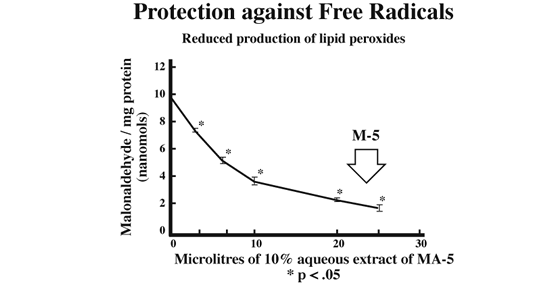
B. Cardiovascular Research
Free radicals play an important role in the causation of coronary heart disease and other cardiovascular disorders. In particular, free radicals oxidize cholesterol and other fats to form oxidized low density lipoprotein [LDL], which then accumulates in damaged arterial walls. In one study, four different Maharishi Ayurveda Rasayanas (M-4, M-5, MA-631, and MA Coffee Substitute) were each hundreds or thousands of times more powerful in preventing oxidation of LDL than other known anti-oxidants, including vitamins C and E [24, 29].
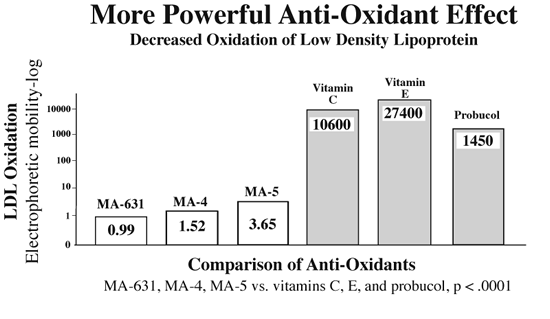
More recently, reduced LDL oxidation has been demonstrated in a clinical research study on people with elevated blood cholesterol levels (please refer to section below on clinical research) [33].
A Maharishi Ayurveda compound (M-5) has been found to prevent the aggregation of human blood platelets in response to four different stimuli. Platelet aggregation contributes to both atherosclerosis and thrombosis—the principal mechanisms leading to coronary heart disease, myocardial infarction (heart attack), and various other cardiovascular disorders [35].

Another study found that addition of a Maharishi Ayurveda herbal preparation (M-4) to the diet led to a 50 percent reduction in coronary artery atherosclerosis in Watanabe rabbits, a species that is genetically highly susceptible to this disorder [36, 37].
A clinical pilot study found improvements in patients with angina pectoris (chest pain due to heart disease) who took two Maharishi Ayurveda Rasayanas (M-4 and M-5) (please refer to section below on clinical research) [38].
C. Prevention of Chemical Toxicity
Maharishi Ayurveda herbal compounds (M-4, M-5, MA Students Rasayana) have been found to protect against tissue damage caused by the solvent toluene (a potent inducer of free radicals and a serious industrial health risk). M-4 and M-5 also decreased toxicity due to adriamycin (a drug commonly used in the treatment of cancer, which is a powerful generator of free radicals) [22, 25, 31, 32]. Addition of Maharishi Ayurveda Rasayanas to the diet led to increased survival rate in animals receiving adriamycin over a four week period [22].
M-4 has also been found to enhance the glutathione anti-oxidant system, a vital natural defence against toxins, and to prevent damage to this system induced by the cancer drug cisplatin [39].
D. Research on Cancer Prevention
A number of studies have found that the Maharishi Ayurveda compounds M-4 and M-5 reduce the development, growth, spread, and mortality of cancer in laboratory animals [40-43].
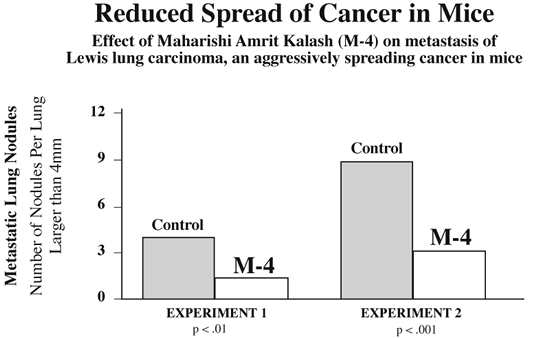
Moreover, in one study M-5 induced both morphological and biochemical differentiation of mouse neuroblastoma cells in culture (thus promoting transformation of abnormal tumour cells towards normal, mature nerve cells) [44].
E. Immunological Research
Maharishi Ayurveda Rasayanas (M-4 and M-5) have been found to enhance the response to foreign antigens of two types of cell that are fundamental to the immune system, without affecting their properties when not challenged. T-lymphocytes showed enhanced proliferation in response to mitogens together with increased production of interleukin-2, an immunomodulator which plays a central role in immune responses. Macrophages showed increased efficiency in killing tumor cells and enhanced production of nitric oxide, which is used to kill bacteria and cancer cells [45-49].
2. Clinical Research
An uncontrolled clinical pilot study examined the effects of Maharishi Ayurveda herbal preparations and other aspects of Maharishi Ayurveda in 126 patients suffering from one of ten common chronic disorders [asthma, chronic bronchitis, rheumatoid arthritis, chronic constipation, eczema, psoriasis, hypertension, non-insulin-dependent diabetes, chronic sinusitis, chronic headaches].
The average duration of these disorders was more than 17 years. After three months of Maharishi Ayurveda treatment, 79% of patients showed clear-cut improvements [50].
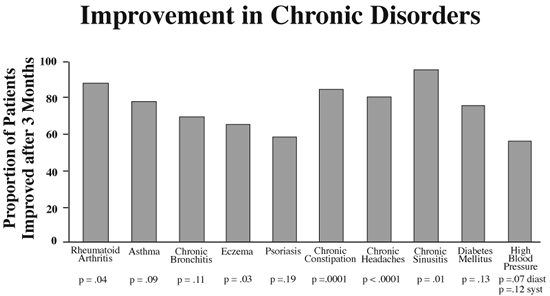
A controlled prospective study of Maharishi Ayurveda herbal preparations (M-4 and M-5) in patients receiving multi-drug chemotherapy for cancer found a reduced incidence of vomiting and diarrhoea, and improved sleep, weight, and overall well-being compared to control patients. Patients also showed reduced free radical activity (as shown by decreased lipid peroxide levels) and less haematological toxicity, indicated by maintenance of higher white blood cell and platelets counts compared to controls [51].
In another clinical pilot study, patients with angina pectoris (chest pain due to heart disease) who took two Maharishi Ayurveda Rasayanas (M-4 and M-5) showed significant reductions in the frequency of chest pain and need for sublingual anti-anginal medication, as well as increased well-being [38].
More recently, M-4 has been shown to prevent LDL oxidation in people with elevated blood cholesterol levels (oxidation of LDL plays in important role in the development of atherosclerosis, especially in those with raised cholesterol) [33].
A pilot trial of a Maharishi Ayurveda compound (MA-471) traditionally purported to have anti-diabetic properties found improved blood sugar control and reduced symptoms in patients with non-insulin dependent diabetes mellitus [2].
3. Research on Cognitive Performance and Perception
A randomized placebo-controlled trial found that a Maharishi Ayurveda Rasayana traditionally recommended for students led to increased growth of intelligence quotient (IQ) in school children over a five month period [52]. Laboratory studies have shown that this compound prevents free radical damage to brain tissue and promotes a biochemical pathway thought to be important for learning and memory [26, 53].
Another randomized placebo-controlled trial found that the herbal preparation Maharishi Amrit Kalash improved performance on a complex measure of visual information processing that is known to deteriorate with ageing [54]. This effect might be mediated by the free radical scavenging properties of this preparation (discussed above) or via interactions with specific neurohormone systems in the brain [55].
PHYSIOLOGICAL PURIFICATION THERAPIES
Research on the Maharishi Ayurveda Physiological Purification Programme has demonstrated benefits for general health and well-being, mental health, and perception, and reductions in cardiovascular risk factors. In one study, subjects who underwent this treatment showed improvements in well-being, energy, stamina, appetite and digestion, and increased feelings of youthfulness compared to control subjects who received only health education over the same time period. In a second study of similar design, subjects who received treatment showed reductions in anxiety, depression and fatigue, and an increase in vigour compared to controls [56]. Another investigation found increased speed of visual information processing [57].
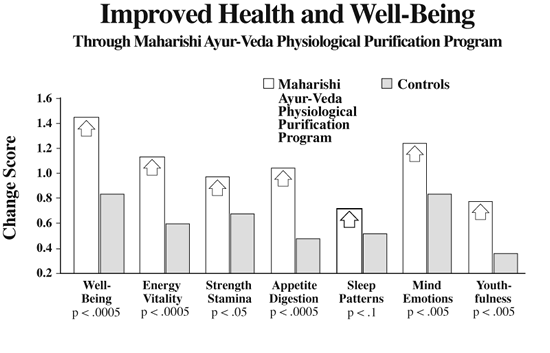
The Maharishi Ayurveda Physiological Purification Programme has also been found to reduce risk factors for coronary artery disease, including reduced serum cholesterol and increased HDL cholesterol (which has a protective effect), reduced lipid peroxides, increased levels of vasoactive intestinal peptide (which dilates coronary arteries), and reductions in pulse rate, diastolic blood pressure, and anxiety [58]. Another study found reduced cholesterol levels and increased emotional stability as a result of treatment [59].
A model has been developed to explain how these purification procedures may produce their effects by removing toxins from the body [60].
VEDIC SOUNDS
Vedic sounds (Sama Veda) have been found to decrease the growth of cancer cells lines in the laboratory compared to a control condition, in contrast to the effect of ‘hard rock’ music which tended to increase growth [61].
COLLECTIVE HEALTH
Maharishi’s Vedic Approach to Health recognises that individual health cannot be divorced from the collective health of society. More than 40 well-controlled studies have now shown that about 1% of the population of a community practising Transcendental Meditation, or an even smaller fraction practising the advanced TM-Sidhi programme, can lead to reduction of negative tendencies (such as violence, crime, accidents, disease, and suicides) and improvement in positive trends (such as economic prosperity) for the whole society [62-75].
Researchers have named this phenomenon the Maharishi Effect, as it was predicted by Maharishi in 1960. Decreased crime rate in the Merseyside region has been demonstrated as a result of this effect [74].
In a published study, a well-designed prospective experiment demonstrated a 23% reduction in violent crime in Washington DC as a result of the Maharishi Effect — a result confirmed by a panel of independent experts [75].
Reduction in crime and other improvements in the quality of life in society have direct benefits for the individual by reducing collective stress and social disharmony, both of which are known to be major factors influencing health standards in the general population.
List of Studies and Publications on Maharishi Ayurveda
1. Sharma HM, Clark C. Contemporary Ayurveda — Medicine and research in Maharishi Ayurveda. Churchill Livingstone, 1998.
2. Sharma HM, Alexander CN. Maharishi Ayurveda: Research Review. Complementary Medicine International, 1996, 3 (2) 16-28.
3. Nader T. Human Physiology — Expression of Veda and Vedic Literature, 1995, Maharishi Vedic University, Vlodrop, The Netherlands.
4. Orme Johnson DW, Herron RE. An innovative approach to reducing medical care utilization and expenditures. American Journal of Managed Care, 1997, 3: 135-144.
5. Scientific Research on Maharishi’s Transcendental Meditation and TM-Sidhi Programme: Collected Papers, Volumes 1-6, Maharishi Vedic University Press, Holland.
6. Orme-Johnson DW. Medical care utilization and the Transcendental Meditation programme. Psychosomatic Medicine, 1987, 49: 493-507.
7. Herron RE, Hillis SL, Mandarino JV, Orne Johnson DW, Walton KG. The impact of the Transcendental Meditation program on government payments to physicians in Quebec. American Journal of Health Promotion, 1996, 10: 208-216.
8. Schneider RH, Staggers F, Alexander CN, Sheppard W, Rainforth M, Kondwani K, Smith S, King CG. A randomized controlled trial of stress reduction for hypertension in older African Americans. Hypertension, 1995, 26: 820-827.
9. Alexander CN, Schneider RH, Staggers F, Sheppard W, Clayborne BM, Rainforth M, Salerno J, Kondwani K, Smith S, Walton KG, Egon B. Trial of stress reduction for hypertension in older African Americans II — Sex and risk subgroup analysis. Hypertension, 1996, 28: 228-237.
10. Cooper M, Aygen M. Transcendental Meditation in the management of hypercholesterolaemia. Journal of Human Stress, 1979, 5: 24-27.
11. Alexander CN, Robinson P, Rainforth M. Treating and preventing alcohol, nicotine, and drug abuse through Transcendental Meditation: A review and statistical meta-analysis. Alcoholism Treatment Quarterly, 1994, 11: 1-2, 13-87.
12. Herron RE, Schneider RH, Mandarino GV, Alexander CN, Walton KG. Cost-effective hypertension management: comparison of drug therapies with an alternative program. American Journal of Managed Care, 1996, 2: 427-437.
13. Zamarra JW, Schneider RH, Besseghini I, Robinson DK, Salerno JW. Usefulness of the Transcendental Meditation programme in the treatment of patients with coronary artery disease. American Journal of Cardiology, 1996, 77, 867-70.
14. Brooks JS, Scarano T. Transcendental Meditation in the treatment of post-Vietnam adjustment. Journal of Counselling and Development, 1986, 64: 212-215.
15. Alexander CN, Langer EJ, Davies JL, Chandler HM, Newman RI. Transcendental Meditation, mindfulness, and longevity: an experimental study with the elderly. Journal of Personality and Social Psychology, 1989, 57, 6: 950-964.
16. Eppley K, Abrams A, Shear J. Differential effects of relaxation techniques on trait anxiety: a meta-analysis. Journal of Clinical Psychology, 1989, 45: 957-74.
17. Alexander CN, Gelderloos P, Rainforth MV. Transcendental Meditation, self-actualization, and psychological health: a conceptual overview and statistical meta-analysis. Journal of Social Behavior and Personality, 1991, 6 (5): 189-247.
18. Haratani T, Henmi T. Effects of Transcendental Meditation on health behavior of industrial workers. Japanese Journal of Public Health, 1990, 37: 729.
19. Haratani T, Henmi T. Effects of Transcendental Meditation on mental health of industrial workers. Japanese Journal of Industrial Health, 1990, 32: 656.
20. Alexander CN, Swanson GC, Rainforth MV, Carlisle TW, Todd CC, Oates RM Jar. Effects of the Transcendental Meditation program on stress-reduction, health, and employee development in two occupational settings. Anxiety, Stress and Coping, 1993, 6: 245-262.
21. Sharma HM. Freedom from disease: How to control free radicals, a major cause of aging and disease. Veda Publishing, 1993, Toronto.
22. Engineer FN, Sharma HM, and Dwivedi C. Protective effects of Maharishi Amrit Kalash on adriamycin-induced microsomal lipid peroxidation and mortality. Biochemical Archives, 1992, 8: 267-72.
23. Niwa Y. Effect of Maharishi-4 and Maharishi-5 on inflammatory mediators with special reference to free radical scavenging effect. Indian Journal of Clinical Practice, 1991, 1: 23-27.
24. Sharma HM, Hanna AN, Kauffman EM, Newman AI. Inhibition of human low-density lipoprotein oxidation in vitro by Maharishi Ayurveda herbal mixtures. Pharmacology, Biochemistry & Behaviour, 1992, 43: 1175-82.
25. Hanna AN, Sharma HM, Kauffman EM, Newman AI. In vitro and in vivo inhibition of microsomal lipid peroxidation by MA-631. Pharmacology, Biochemistry & Behaviour, 1994, 48 (2): 505-510.
26. Hanna AN, Kauffman EM, Newman AI, Sharma HM. Prevention of oxidant stress by student rasayana (SR). In: Free Radicals in diagnostic medicine: A systems approach to laboratory technologies, clinical correlations, and antioxidant therapy. D Armstrong (Ed), Plenum Press, New York 1994, 444-445.
27. Dwivedi C, Sharma HM, Dobrowski S, Engineer FN. Inhibitory effects of Maharishi-4 and Maharishi-5 on microsomal lipid peroxidation. Pharmacology Biochemistry & Behaviour, 1991, 39: 649-652.
28. Hanna AN, Sharma HM, Lubow GP, Titterington LC, Stephens RE. Possible mechanism of action of Student Rasayana for improving brain functioning. Federation of American Societies of Experimental Biology Journal, 1994, 8(5): 658.
29. Sharma HM, Hanna AN, Titterington LC, Stephens RE. Effect of MAK-4 and MAK-5 on endothelial cell- and soyabean lipoxygenase-induced LDL oxidation. In Free Radicals in Diagnostic Medicine: A Systems Approach to Laboratory Technologies, Clinical Correlations, and Antioxidant Therapy. D. Armstrong (ed.). 1995, New York: Plenum Press.
30. Lee JY, Lott JA, Sharma HM. Biochemical changes induced by Maharishi Amrit Kalash (MAK-4) and MA-208 in diet-induced hypercholesterolemic rabbits. In Free Radicals in Diagnostic Medicine: A Systems Approach to Laboratory Technologies, Clinical Correlations, and Antioxidant Therapy. D. Armstrong (ed.). 1995, New York: Plenum Press.
31. Bondy S, Hernandez TM, Mattia C. Anti-oxidant properties of two herbal preparations. Biochemical Archives, 1994, 10: 25-31.
32. Sharma HM, Hanna AN, Kauffman EM, Newman HAI. Effect of herbal mixture Student Rasayana on lipoxygenase activity and lipid peroxidation. Free Radicals in Biology and Medicine, 1995, 18: 687-697.
33. Sundaram V, Hanna, AN, Lubow G, Falko J, Sharma HM. Increased resistance of human LDL to oxidation in hyperlipidemic patients supplemented with oral herbal mixture MAK-4. Federation of American Societies of Experimental Biology Journal, 1995, 9(3): A141.
34. Lee JY. The antioxidant and antiatherogenic effects of MAK-4 in WHHL rabbits. PhD Dissertation. 1995, The Ohio State University, Columbus, Ohio, USA.
35. Sharma HM, Feng Y, Panganamala RV. Maharishi Amrit Kalash (MAK) prevents human platelet aggregation. Clinical & Terapia Cardiovascular, 1989, 3: 227-230.
36. Lee JY, Lott, JA, Kauffman EM, and Sharma HM. Effects of herbal mixture MAK-4 on organ functions in WHHL rabbits. Biochemical Archives, 1997, 13: 285-296.
37. Lee JY, Hanna AN, Lott, JA, and Sharma HM. The antioxidant and antiatherogenic effects of MAK-4 in WHHL rabbits. Journal of Alternative and Complementary Medicine, 1996, 2(4): 463-478.].
38. Dogra J, Grover N, Kumar P, Aneja N. Indigenous free radical scavenger MAK 4 and 5 in angina pectoris. Is it only a placebo? Journal of the Association of Physicians of India, 1994, 42 (6).
39. Sharma HM, Guenther J, Abu-Ghazaleh, Dwivedi C. Effects of Ayur-Vedic food supplement M-4 on cisplatin-induced changes in glutathione and glutathione-S-transferase activity. Proceedings of the XVI International Cancer Congress, Vol. 1, 1994, Rao RS, Deo MG, Sanghvi LD. (eds.), pp. 589-592. Bologna (Italy): Monduzzi Editore.
40. Sharma HM, Dwivedi C, Satter BC, Gudehitihlu HA, Malarkey W, Tejwani GA. Anti-neoplastic properties of Maharishi-4, against DMBA-induced mammary tumours in rats. Pharmacology, Biochemistry, and Behaviour, 1990, 35: 767-773.
41. Sharma HM, Krieger J, Dwivedi C. Antineoplastic properties of dietary Maharishi-4 and Maharishi Amrit Kalash Ayurvedic food supplements. European Journal of Pharmacology, 1990, 183: 193.
42. Patel VK, Wang J, Shen RN, Sharma HM, Brahmi Z. Reduction of metastasis of Lewis lung carcinoma by an Ayurvedic food supplement in mice. Nutritional Research, 12: 51-61, 1992.
43. Sharma HM, Dwivedi C, Satter BC, Abou-Issa H. Antineoplastic properties of Maharishi Amrit Kalash, an ayurvedic food supplement, against 7,12-dimethylbenz (a) anthracene-induced mammary tumours in rats. Journal of Research and Education in Indian Medicine, 1991, 10(3): 1-8.
44. Prasad KN, Edwards-Prasad J, Kentroti, S, Brodie C, and Vernadakis A. Ayurvedic (science of life) agents induce differentiation in murine neuroblastoma cells in culture. Neuropharmacology, 1992, 31: 599-607.
45. Dileepan KN, Varghese ST, Page JC, Stechschulte DJ. Enhanced lymphoproliferative response, macrophage-mediated tumour cell killing, and nitric oxide production after ingestion of an Ayurvedic drug. Biochemical Archives, 1993, 9: 365-374.
46. Dileepan KN, Patel V, Sharma HM, Stechschulte DJ. Priming of splenic lymphocytes after ingestion of an Ayurvedic herbal food supplement: evidence for an immunomodulatory effect. Biochemical Archives, 1990, 6: 267-274.
47. Inaba R, Sugiura H, Iwata H, Mori H, Tanaka T. Immunomodulatory effects of Maharishi Amrit Kalash 4 in mice. Journal of Applied Nutrition, 1996, 48(1-2): 10-21.
48. Inaba R, Sugiura H, Iwata H, Tanaka T. Dose-dependent activation of immune function in mice by ingestion of Maharishi Amrit Kalash 5. Environmental Health and Preventive Medicine, 1997, 2(1): 35-39.
49. Inaba R, Sugiura H, Iwata H. Immunomodulatory effects of Maharishi Amrit Kalash 4 and 5 in mice. Japanese Journal of Hygiene, 1995, 50: 901-905.
50. Janssen G. Maharishi Ayur-Ved in the treatment of ten common chronic disorders — a pilot study. Nederlands Tijdschrift voor Integrale Geneeskunde, 1989, 5: 586-594.
51. Mishra NC, Sharma HM Chaturvedi A, Ramakant, Srivastav S, Devi V, Kakkar P, Vishwanathan, Natu SM, and Bogra J. Anti-oxidant adjuvant therapy using a natural herbal mixture (MAK) during intensive chemotherapy: reduction in toxicity. A prospective study of 62 patients. Proceedings of the XVI International Cancer Congress, Vol. 1, 1994, Rao RS, Deo MG, Sanghvi LD (eds.), pp. 3099-3102. Bologna (Italy): Monduzzi Editore.
52. Nidich SI, Morehead P, Nidich RJ, Sands D, Sharma H. The effect of Maharishi Student Rasayana on non-verbal intelligence. Personality and Individual Differences, 15 (5) 599-602, 1993.
53. Hanna AN, Sharma, HM, Lubow GP, Titterington LC, Stephens RE. Possible mechanism of action of Student Rasayana for improving brain functioning. Federation of American Societies of Experimental Biology Journal, 1994, 8(5): 658.
54. Gelderloos P, Ahlstrom HHB, Orme-Johnson DW, Robinson DK, Wallace RK, Glaser JL. Influence of a Maharishi Ayur-Vedic herbal preparation on age-related visual discrimination. International Journal of Psychosomatics, 1990, 37 (1-4): 29.
55. Sharma HM, Hanissian S, Rattan AK, Stern SL, Tejwani GA. Effect of Maharishi Amrit Kalash on brain opioid receptors and neuropeptides. Journal of Research and Education in Indian Medicine, 1991, 10(1): 1-8.
56. Schneider RH, Cavanaugh KL, Kasture HS, Rothenberg S, Averbach R, Robinson D, Wallace RK. Health promotion with a traditional system of natural health care: Maharishi Ayurveda. Journal of Social Behavior and Personality, 1990, 5(3): 1-27.
57. Nidich SI, Smith DE, Sands D, Sharma H, Nidich RJ, Barnes V, Jossang S. Effect of Maharishi Ayur-Ved Panchakarma purification program on speed of processing ability. Maharishi International University, Fairfield, Iowa, USA.
58. Sharma HM, Nidich SI, Sands D, Smith DE. Improvement in cardiovascular risk factors through Panchakarma purification procedures. Journal of Research and Education in Indian Medicine, 1993, XII: 4, 2-13.
59. Waldschütz R. Veränderungen physiologischer und psychischer Parameter durch eine ayurvedische Reinigungskur. Erfahrungsheilkunde - Acta Medica Empirica, 1988, 11: 720-729.
60. Smith DE, Salerno JW. A model for extraction of both lipid-soluble and water-soluble toxins using a procedure from Maharishi Ayurveda. Medical Hypotheses, 1992, 39: 1-5.
61. Sharma HM, Kauffman EM, Dudek A, Stephens RE. Effect of different sounds on growth of human cancer lines in vitro. Alternative Therapies in Clinical Practice, 1996, 3 (4) 25-32.
62. Dillbeck M, Landrith G, Orme-Johnson D. The Transcendental Meditation program and crime rate change in a sample of forty-eight cities. Journal of Crime and Justice, 1981, 4: 25-45.
63. Dillbeck M, Cavanaugh K, Glenn T, Orme-Johnson D, Mittlefeldt V. Effects of Transcendental Meditation and the TM-Sidhi program on quality of life indicators: Consciousness as a field. The Journal of Mind and Behaviour, 1987, 8: 67-104.
64. Gelderloos P, Frid MJ, Goddard PH, Xue X, Loliger SA. Creating world peace through the collective practice of the Maharishi Technology of the Unified Field: improved US-Soviet relations. Social Science Perspectives Journal, 1988, 2(4): 80-94.
65. Orme-Johnson DW, Alexander CN, Davies JL, Chandler HM, Larimore WE. International peace project in the Middle East: the effects of the Maharishi Technology of the Unified Field. Journal of Conflict Resolution, 1988, 32(4): 776-812.
66. Orme-Johnson DW, Alexander CN, Davies JL. The effects of the Maharishi Technology of the Unified Field. Journal of Conflict Resolution, 1990, 34(4): 756-868.
67. Dillbeck M, Banus CB, Polanzi C, Landrith GS. Test of a field model of consciousness and social change: Transcendental Meditation and TM-Sidhi program and decreased urban crime. The Journal of Mind and Behaviour, 1989, 9(4): 457-486.
68. Dillbeck MC. Test of a field hypothesis of consciousness and social change: time series analysis of participation in the TM-Sidhi program and reduction of violent death in the U.S. Social Indicators Research, 1990, 22: 399-418.
69. Orme-Johnson DW, Dillbeck M, Wallace RK, Landrith GS. Intersubject EEG coherence: is consciousness a field? International Journal of Neuroscience, 1982, 16: 203-209.
70. Cavanaugh KL. Time series analysis of US and Canadian inflation and unemployment: a test of a field theoretic hypothesis. Proceedings of the American Statistical Association, Business and Economics Statistics Section, 1987, 799-804. Alexandria, Virginia: American Statistical Association.
71. Cavanaugh KL, King KD. Simultaneous transfer function analysis of Okun's misery index: improvement in the economic quality of life through Maharishi's Vedic science and technology of consciousness. Proceedings of the American Statistical Association, Business and Economics Statistics Section, 1988, 491-496. Alexandria, Virginia: American Statistical Association.
72. Cavanaugh KL, King KD, Ertuna C. A multiple-input transfer function model of Okun's misery index: an empirical test of the Maharishi Effect. Proceedings of the American Statistical Association, Business and Economics Statistics Section, 1989. Alexandria, Virginia: American Statistical Association.
73. Cavanaugh KL, King KD, Titus BD. Consciousness and the quality of economic life: empirical research on the macroeconomic effects of the collective practice of Maharishi's Transcendental Meditation and TM-Sidhi program. Proceedings of the Midwest Management Society, 1989, 183-190. Chicago: Midwest Management Society.
74. Hatchard GD, Deans AJ, Cavanaugh KL, Orme Johnson DW. The Maharishi Effect: A model for social improvement. Time series analysis of a phase transition to reduced crime in Merseyside Metropolitan Area. Psychology, Crime and Law, 1996, 2: 165-174.
75. Hagelin JS, Rainforth MV, Orme-Johnson DW, Cavanaugh KL, Alexander CN, Shatkin SF, Davies JL, Hughes AO, Ross E. Effects of group practice of the Transcendental Meditation program on preventing violent crime in Washington D.C.: Results of the National Demonstration Project, June-July 1993. Social Indicators Research, 47: 153-201.
Detailed summary available as a PDF download (21MB)






